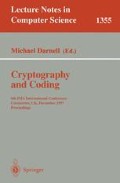Abstract
In this paper, we propose a restrictive blind signature scheme with enhanced security for the signer. It is suitable to be used as a basic cryptographic primitive in the design of a privacy protecting off-line electronic payment system. The solution is derived from the transformation of a witness hiding proof of knowledge. In order to blindly sign a message, preserving a certain invariant structure of this message, a proof of knowledge of a representation is diverted. The choice of a witness hiding proof system improves the security and provability of the restrictive blind signature scheme. This is the main contribution of our solution. The cost paid for enhanced security is reasonable with regard to the overall efficiency of the scheme.
Preview
Unable to display preview. Download preview PDF.
References
M. Bellare and P. Rogaway, “Random oracles are practical: a paradigm for designing efficient protocols,” Proc. of the 1st ACM Conference on Computer and Communications Security, 1993, pp. 62–73.
S. Brands, An efficient off-line electronic cash system based on the representation problem, Report CS-R9323, Centrum voor Wiskunde en Informatica, March 1993.
D. Chaum, “Blind signatures for untraceable payments,” Advances in Cryptology, Proc. Crypto'82, D. Chaum, R.L. Rivest and A.T. Sherman, Eds., Plenum Press, New York, 1983, pp. 199–203.
D. Chaum and T.P. Pedersen, “Wallet databases with observers,”Advances in Cryptology, Proc. Crypto'92, LNCS 740, E.F. Brickell, Ed., Springer-Verlag, 1993, pp. 89–105.
L. Chen, Witness Hiding Proofs and Applications, PhD thesis, Aarhus University, Computer Science Department, Aarhus (Denmark), August 1994.
U. Feige, A. Fiat and A. Shamir, “Zero-knowledge proofs of identity,” Journal of Cryptology, Vol. 1, No. 2, 1988, pp. 77–94.
U. Feige and A. Shamir, “Witness indistinguishable and witness hiding protocols,” Proc. of the 22nd Annual ACM Symposium on Theory of Computing, 1990, pp. 416–426.
A. Fiat and A. Shamir, “How to prove yourself: Practical solutions to identification and signature problems,” Advances in Cryptology, Proc. Crypto'86, LNCS 263, A.M. Odlyzko, Ed., Springer-Verlag, 1987, pp. 186–194.
S. Goldwasser, S. Micali and R.L. Rivest, “A digital signature scheme secure against adaptive chosen-message attacks,” SIAM J. on Comput., No. 17, 1988, pp. 281-308.
T. Okamoto, “Provably secure and practical identification schemes and corresponding signature schemes,” Advances in Cryptology, Proc. Crypto'92, LNCS 740, E.F. Brickell, Ed., Springer-Verlag, 1993, pp. 31–53.
T. Okamoto and K. Ohta, “Divertible zero knowledge interactive proofs and commutative random self-reducibility,” Advances in Cryptology, Proc. Eurocrypt'89, LNCS 434, J.-J. Quisquater and J. Vandewalle, Eds., Springer-Verlag, 1990, pp. 134–149.
D. Pointcheval and J. Stern, “Security proofs for signature schemes,” Advances in Cryptology, Proc. Eurocrypt'96, LNCS 1070, U. Maurer, Ed., Springer-Verlag, 1996, pp. 387–398.
D.Pointcheval and J. Stern, “Provably secure blind signature schemes,”Advances in Cryptology, Proc. Asiacrypt'96, LNCS 1163, K. Kim and T. Matsumoto, Eds., Springer-Verlag, 1996, pp. 252–265.
C.P. Schnorr, “Efficient signature generation by smart cards,” Journal of Cryptology, Vol. 4, No. 3, 1991, pp. 161–174.
Author information
Authors and Affiliations
Editor information
Rights and permissions
Copyright information
© 1997 Springer-Verlag Berlin Heidelberg
About this paper
Cite this paper
Radu, C., Govaerts, R., Vandewalle, J. (1997). Witness hiding restrictive blind signature scheme. In: Darnell, M. (eds) Crytography and Coding. Cryptography and Coding 1997. Lecture Notes in Computer Science, vol 1355. Springer, Berlin, Heidelberg. https://doi.org/10.1007/BFb0024474
Download citation
DOI: https://doi.org/10.1007/BFb0024474
Published:
Publisher Name: Springer, Berlin, Heidelberg
Print ISBN: 978-3-540-63927-5
Online ISBN: 978-3-540-69668-1
eBook Packages: Springer Book Archive

